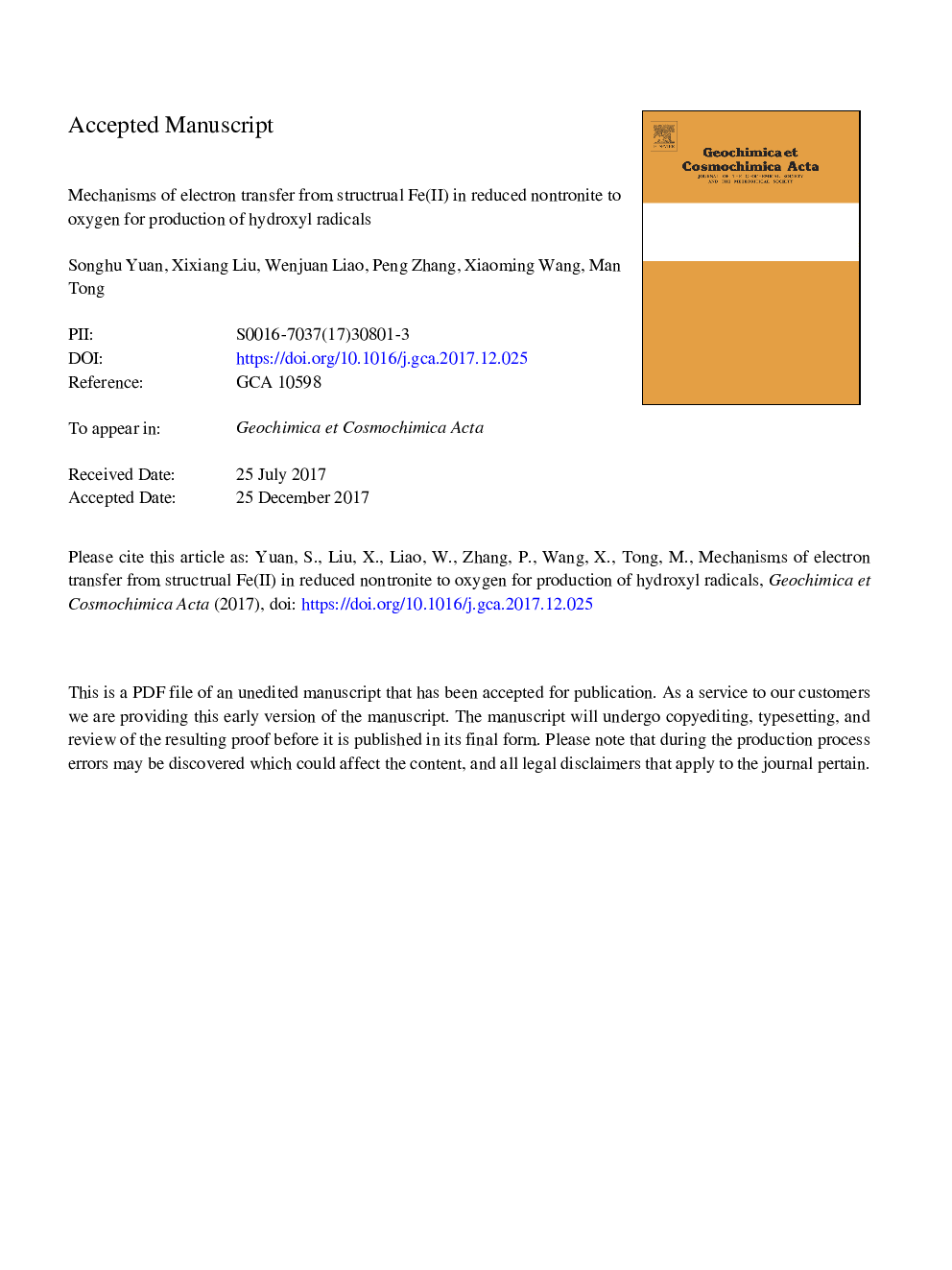| کد مقاله | کد نشریه | سال انتشار | مقاله انگلیسی | نسخه تمام متن |
|---|---|---|---|---|
| 8910916 | 1637934 | 2018 | 53 صفحه PDF | دانلود رایگان |
عنوان انگلیسی مقاله ISI
Mechanisms of electron transfer from structrual Fe(II) in reduced nontronite to oxygen for production of hydroxyl radicals
دانلود مقاله + سفارش ترجمه
دانلود مقاله ISI انگلیسی
رایگان برای ایرانیان
کلمات کلیدی
موضوعات مرتبط
مهندسی و علوم پایه
علوم زمین و سیارات
ژئوشیمی و پترولوژی
پیش نمایش صفحه اول مقاله

چکیده انگلیسی
Production of hydroxyl radicals (OH) has been recently revealed upon oxygenation of sediments in redox-dynamic subsurface environments. In particular, Fe(II)-bearing clay minerals are the major sediment components contributing to OH production upon oxygenation, and the produced OH can oxidize contaminants and inactivate bacteria. Whereas, the mechanisms of OH production from oxygenation of Fe(II)-bearing clay minerals remain elusive. The objectives of this study were to identify the structural variation of Fe(II) entities during the oxidation of Fe(II)-bearing clay minerals by O2, and to unravel the mechanisms of electron transfer within the mineral structure and from mineral to O2 for OH production. Nontronite (NAu-2, 23% Fe) which was chemically reduced to 54.5% Fe(II) in total Fe was used as a model Fe(II)-bearing clay mineral. Production of OH and oxidation of Fe(II) were measured during the oxidation of reduced NAu-2 by O2. A wide spectrum of spectroscopic techniques, including Fourier transform infrared spectroscopy (FTIR), Fe K-edge X-ray absorption spectroscopy (XAS), Mössbauer spectra, and X-ray photoelectron spectroscopy (XPS), were employed to explore the structural variation of Fe(II) entities in NAu-2 and the electron transfer within NAu-2 and from NAu-2 to O2. For 180â¯min oxidation of 1â¯g/L reduced NAu-2, a biphasic OH production was observed, being quick within the initial 15â¯min and slow afterwards. Production of OH correlates well with oxidation of Fe(II) in the reduced NAu-2. Within the initial 15â¯min, trioctahedral Fe(II)-Fe(II)-Fe(II) entities and edge Fe(II) in the reduced NAu-2 were preferentially and quickly oxidized, and electrons from the interior Fe(II)-Fe(II)-Fe(II) entities were most likely ejected from the basal siloxane plane to O2. Meanwhile, trioctahedral Fe(II)-Fe(II)-Fe(II) entities were mainly transformed to dioctahedral Fe(II)-Fe(II) entities. When the time of oxygenation was longer than 15â¯min, dioctahedral Al-Fe(II), Fe(II)-Fe(II) and Fe(II)-Fe(III) entities were slowly oxidized, and the interior electrons were transported through Fe(II)-O-Fe(III) linkages to edges and then ejected to O2. In the slow stage of oxidation, electrons from interior Fe(II) accumulated towards the near surface layers and fueled the regeneration of edge Fe(II) for OH production. In both stages, one-electron transfer mechanism with the involvement of O2â and H2O2 applies for OH production from the oxidation of structural Fe(II) by O2. The mechanisms unraveled in this study advance the understanding of reactive oxygen species (ROS) production and structural Fe variation when Fe(II)-bearing clay minerals are oxygenated in redox-dynamic systems.
ناشر
Database: Elsevier - ScienceDirect (ساینس دایرکت)
Journal: Geochimica et Cosmochimica Acta - Volume 223, 15 February 2018, Pages 422-436
Journal: Geochimica et Cosmochimica Acta - Volume 223, 15 February 2018, Pages 422-436
نویسندگان
Songhu Yuan, Xixiang Liu, Wenjuan Liao, Peng Zhang, Xiaoming Wang, Man Tong,